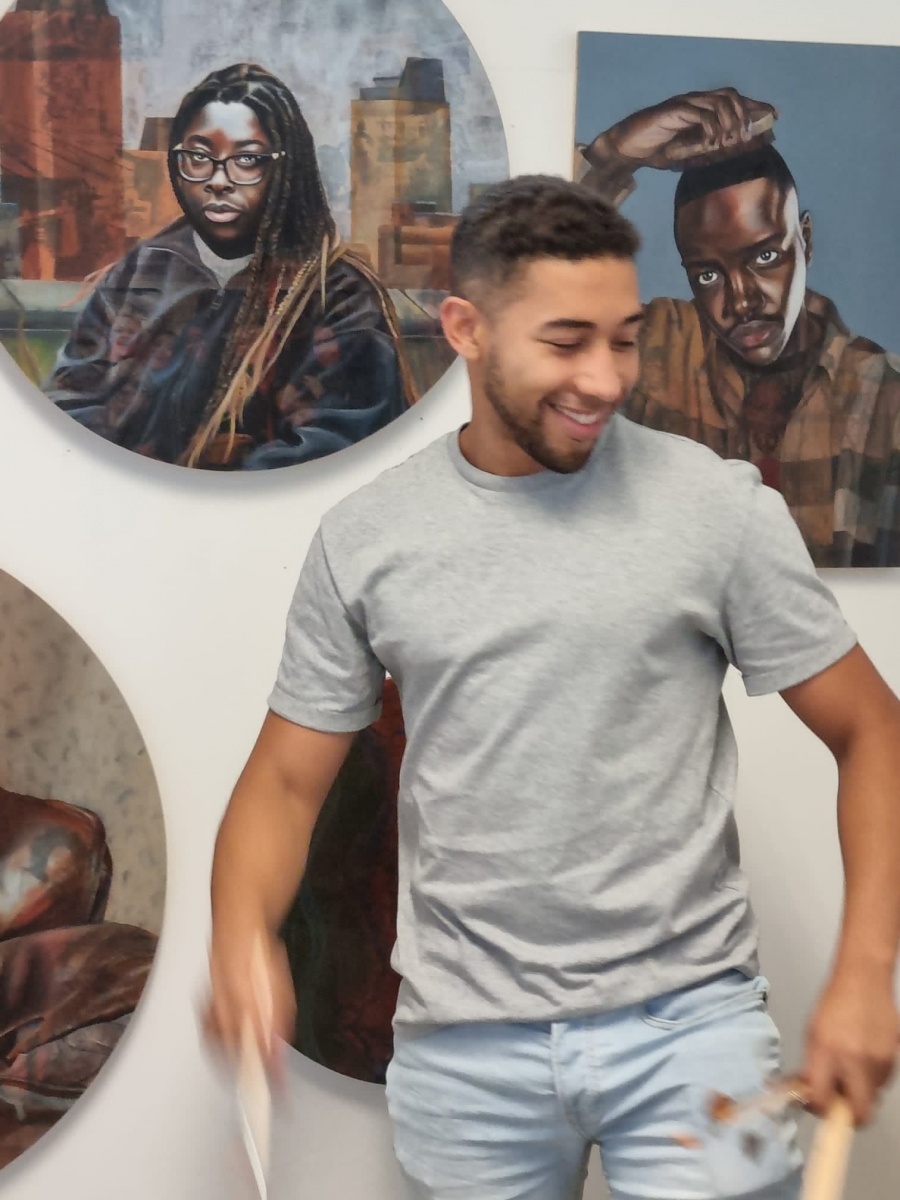Joshua Donkor is a Ghanian-British painter whose work uses portraiture as a tool to subvert monolithic portrayals of Black identity. Joshua approaches portraiture as a collaborative exercise between him and his sitters. His process involves meeting with the subjects of his paintings on multiple occasions and going through their personal effects and photographs. Joshua works with them to identify the images that most potently convey the details of their personal narrative, including family photos, fabrics, and personal belongings. Each portrait he paints includes both the image of the sitter, as well as layered visual references to all of the items they picked out together. The material depth of the paintings comes about through Joshua's method of transferring layer after layer onto the surfaces of his paintings. Using a range of different painting and printing and layering techniques, he literally embeds the histories of his sitters into the work. Although the subject matter of Joshua’s paintings is deeply personal and completely idiosyncratic—often having to deal with specific African roots and the individual experiences specific people have had growing up Black in Western societies—all types of viewers have been able to respond deeply to the images. Somehow, widely relatable content is communicated through the specificity of the images.

1) Which art movement do you consider most influential on your practice?
The Dutch Golden Age is probably one of my favorites. The technical quality of the painters from that era along with the rich narrative depth behind the work has always been a source of inspiration for me. I still often look to the works of Rembrandt and Frans Hals as references when designing the compositions of my portraits.
2) Where do you go and when to make your best art?
It really depends on which stage of my process I’m currently at. Often my process starts with writing, so for this stage traveling around and social environments are the best place to generate new ideas and have interesting conversations. Ghana has often been the place where this process happens for me. For the physical creation of my paintings, I like to be alone working in my studio late at night.
3) How do you describe your 'creative process'?
I always describe my practice as visual storytelling. My aim for every portrait I create is to try and offer a glimpse into the subjects' life and experiences which have informed their sense of identity.
4) Which artist, living or deceased, is the greatest inspiration to you?
It's very hard to only name one! Classical painters like Georges de La Tour and Rembrandt often come to mind. I would probably name the of likes of Kehinde Whiley and Njideka Akunyili Crosby as contemporary sources of inspiration. Both these artists in particular have had a big impact on the approach to making work and painting.
5) If you weren't an artist, what would you do?
I quite like the idea of attempting to be some sort of writer, maybe either as a journalist or an author. I like the idea of any career that would require some kind of travel and chances for new experiences.
6) What do you listen to for inspiration?
I think it depends on my mood really. I tend to make playlists that I listen too when I’m working in the studio. Bob Marley and Loyal Carner probably crop up a lot.
7) If you could own one artwork, and money was no object, which piece would you acquire?
“Joseph the Carpenter” by Georges de La Tour. I was fortunate enough to see this painting in person at the Louvre. It’s probably the most beautiful painting I’ve seen, his ability to capture light is utterly masterful.
8) If your dream museum or collection owner came calling, which would it be?
I think I would probably say the National Portrait Gallery. It’s a gallery with so much history and stores the works of some of the greatest artists who ever lived. I’ve made sure to visit as much as possible since I was quite young. Having any work displayed in there would be an incredible honor.
9) What is your key piece of advice for artists embarking on a fine art or creative degree today?
I think my main piece of advice would be to follow up on every opportunity that presents itself, you never know what it might lead to.
10) What is your favourite book of all time (fiction or non fiction)?
Again it’s hard to name only one. I have a particularly soft spot for a book I grew up with called “Gorilla” by Anthony Browne. It’s a very simple story about the relationship between a young girl and her Father with minimal text. Yet it is incredibly emotive story with beautifully sensitive illustrations filling every page.
11) What was the biggest lesson your university course or time studying taught you?
I think the biggest lesson from my time at University was the importance of creating work which I have a personal interest in and connection to. This has always been and the heart of my best work.
12) And finally, if we were to fast forward 10 years, where would we find you?
In 10 years I’d love to own a permanent studio in or close to London and be travelling and exhibiting my work across the world.
Learn more about Joshua and discover his collection of paintings.














